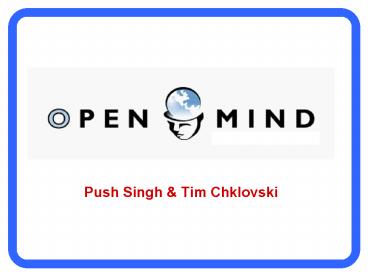Push Singh - PowerPoint PPT Presentation
1 / 11
Title:
Push Singh
Description:
Parsed & sense-tagged corpora, paraphrases, translations. Commonsense reasoning: ... Online supervised learning (i.e. Stork's Animals) ... – PowerPoint PPT presentation
Number of Views:23
Avg rating:3.0/5.0
Title: Push Singh
1
Push Singh Tim Chklovski
2
AI systems need data lots of it!
- Natural language processing
- Parsed sense-tagged corpora, paraphrases,
translations - Commonsense reasoning
- Facts, descriptions, scripts, rules, exceptions
- Computer vision and speech recognition
- Segmented images, transcribed speech
- Robotics
- Motion capture data, body configurations
3
Traditional Sources
- 1. Knowledge engineering, programming
- pro can be high quality
- cons
- - often brittle because lack of coverage
- - expensive!
- 2. Learning from raw data
- pro there is sometimes a lot of raw data
- cons
- - you have little control over the data
- - for many tasks the data is not available
- - hard to learn structured representations
4
Solution turn to the general public!
- There are 500,000,000 people on-line
(Nielsen/NetRatings) - People can participate by
- Providing labeled training examples (i.e. for
OCR) - Tagging corpora (with part-of-speech, word
senses) - Verifying and cleaning data (validating
assertions) - Supplying rules and examples (assertions,
stories) - Evaluating performance of systems (i.e. of face
recognizer) - Online supervised learning (i.e. Storks Animals)
- Organizing and structuring information (i.e. the
web)
5
Successful Distributed Human Projects
- The Open Directory Project (www.dmoz.org)
- indexes 3,248,314 sites
- 46,846 editors
- FreeDB (www.freedb.org)
- 543,786 CDs catalogued
- Others
- The Internet Movie Database (www.imdb.com)
- American Psychological Society (psych.hanover.edu)
- Distributed Proofreaders (charlz.dns2go.com/gutenb
erg) - NASA Crater marking project (clickworkers.arc.nasa
.gov/top)
6
Open Mind Common Sense
- Second-largest commonsense database after Cyc
- - 410,000 assertions, stories, descriptions,
rules, etc. - Built by 8600 users over 1 ½ years
- Can extract relations and rules via shallow
parsing - Basis for several applications and experiments
- - ARIA photo annotation and retrieval agent
- - GOOSE commonsense search engine
- - MAKEBELIEVE story generator
- - intelligent camera, analogical reasoner
- - word sense disambiguator
- (Henry Lieberman, Hugo Liu, Barbara Barry, Thomas
Lin)
7
The Snowball Effect
- Two systems that leverage what they already know
and give feedback to the contributors - Word Sense Disambiguation
- - Lets users select what sense a word is used in
in a given sentence - - Uses collected information to decide where more
learning is needed. - - Provides feedback on how much an automatic
tagger has improved because of your contribution - (learner.media.mit.edu/cgi/wsd-collect-tagging.cgi
) - Learner
- - Gathers commonsense knowledge by asking
questions that the system thinks may be true - - Questions are formed by making analogies, based
on existing knowledge - (forthcoming, see www.media.mit.edu/timc/learner)
8
The Pyramid of Tasks
- Core
- write plug-ins
- contribute inference rules
- contribute and verify simple assertions
- This is because the prior experience required is
an inverse pyramid - some lisp / scheme experience, knowledge
representation / AI background - knowledge rep / ai background or interest, some
programming - analytical skills, familiarity with reasoning
- possess common sense
9
Future Open Mind Projects
- - Using webcams, thousands of people help teach
their computers to recognize the appearance and
behavior of various kinds of objects. - - A system that reads text on the web, but has
people help it comprehend passages. - - A dialogue system that people teach how to have
a conversation. - - Using future cell phones and wearable
computers, we could all start to teach computers
the patterns of our everyday lives by letting
them see and hear us as we actually do things in
the world.
10
Open Questions
- - How do we get users hooked?
- - How do we acquire more sophisticated knowledge?
- - Can we acquire hard-to-articulate knowledge?
- - How do we use knowledge that is easy to
acquire?
11
Fear, Rejoice,
- Fear
- You have to learn how to build a community of
contributors. - You have to make your research accessible.
- Rejoice
- Unlimited number of urops!
- Mom and Dad
- Come to our web site! You can help too.
- Discoveries
- If you build it they will come.
- Malevolent users not a big problem.
- Recent
- Built 2nd largest commonsense database.
- Useful in prototype applications.































